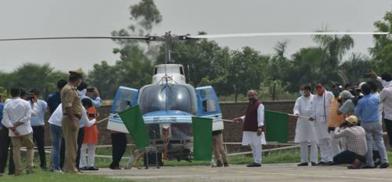India prepares to use helicopter-launched locust control system
“China ne pissu bheja aur Pakistan ne tiddiyan bhej di” (China sent us a virus and Pakistan sent us locusts) was a wry comment by a shopkeeper in Delhi

“China ne pissu bheja aur Pakistan ne tiddiyan bhej di” (China sent us a virus and Pakistan sent us locusts) was a wry comment by a shopkeeper in Delhi.
While some western parts of India have been visited by locust swarms for quite a few years, the locust invasion in India this year has been on a much larger scale and considered as the worst in a quarter-century. Billions of locusts have reportedly engulfed tens of thousands of hectares of agricultural area, spread across seven Indian states. Though causing no direct harm to humans, the insects continue to threaten crops and vegetation and, effectively, the livelihood of hundreds of farmers.
Anticipating the locust attack, India's Ministry of Agriculture signed a contract with M/s Micron, UK to modify two Mi-17 helicopters for spraying atomized pesticide to arrest locust breeding. Due to COVID-19 pandemic, the UK based firm would be able to manufacture and supply the modification kit to the Indian Air Force (IAF} only from September 2020 onwards for system integration and testing. Meanwhile, an unprecedented locust attack started manifesting from the last week of May and was fast spreading practically across many states.
In view of envisaged delay in provisioning of modification kits by M/s Micron, the Indian Air Force tasked No. 3 Base Repair Depot located at Chandigarh to undertake the challenging task of indigenously designing and developing an Airborne Locust Control System (ALCS) for Mi-17 helicopters. Using all indigenous components, the atomized airborne spraying of pesticide has been successfully achieved in air through a configuration of nozzles mounted both sides on external trusses of a Mi-17 helicopter. The nozzles used for the purpose are a mix of commercially available nozzles as well as those developed by CSIO, Chandigarh. The pesticide Malathion in appropriate concentration would be in the internal auxiliary tank of 800 liters capacity fitted inside the helicopter and pumped into the nozzles by using an electrical pump as well as compressed air, achieving nearly 40 minutes of spaying duration in the infected zone covering an area of approximately 750 hectares in each mission.
A team of test pilots and test engineers of Aircraft and Systems Testing Establishment, Bangalore have successfully carried out ground and airborne trials of ALCS on a modified Mi-17 helicopter. The system is being offered for use with Malathion for employment in the locust control operation.
Being an indigenously developed system, the ALCS would offer inherent advantages of in-house maintenance, future upgradeability, saving of foreign exchange and help in making the country self-reliant in aviation-related technology.
Experts have noted two unusual aspects of the locust swarms this year—one is that they have arrived much earlier than their usual migratory time; and two, they have travelled far beyond their usual hunting ground, and invaded states like Uttar Pradesh, Madhya Pradesh and Maharashtra. Usually, locusts arrive in India during the monsoon months, between July and October. But this year, the first sighting was reported as early as April 11.
The cause for this unusual pattern this year is linked to the cyclonic storms Mekunu and Luban, which impacted Oman and Yemen in 2018. These storms turned large desert areas in those countries into lakes, which created ideal hubs for the locusts to breed. According to a FAO report, locust swarms have been breeding 400 times more than usual, and this explosive multiplication may lead to bigger disasters for large parts of Asia and Africa in the near future. Following the mentioned cyclones, locust swarms continued to build through 2019, and once their population peaked, they began spreading to East Africa by November 2019.
The invasion in Iran and Pakistan was complete by the beginning of 2020 until they reached India towards the end of April.
(The author, a strategic analyst and former spokesperson Ministry of Defence and Indian Army, can be contacted at wordsword02@gmail.com)










Post a Comment